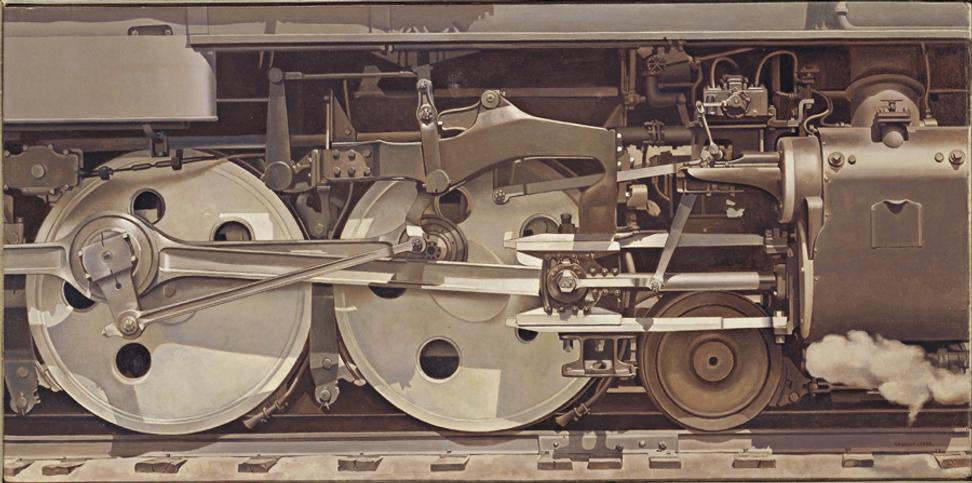de Young
March 24 through August 12, 2018
Dallas Museum of Art
September 9, 2018, through January 6, 2019
The Fine Arts Museums of San Francisco (FAMSF) is set to premiere Cult of the Machine: Precisionism and American Art, the first large-scale exhibition in over 20 years to survey this characteristically American style of early twentieth-century Modernism. Organized by FAMSF and on view at the de Young, the exhibition addresses the aesthetic and intellectual concerns that fueled the development of this artistic style during the 1920s and 1930s.

More than 100 Precisionist masterworks by seminal artists such as Charles Sheeler, Georgia O’Keeffe, and Charles Demuth are displayed alongside prints by photographers such as Imogen Cunningham and Paul Strand; clips from films such as Charlie Chaplin’s Modern Times; and extraordinary decorative arts and industrial objects from the period—including a vintage Cord Phaeton automobile—to reflect the widespread embrace of a machine-age aesthetic by artists, designers, and the public alike.
Cult of the Machineconsiders how the style reflects the economic and social changes wrought by industrialization and technological progress during the Machine Age in America. Visitors are encouraged to draw connections to our own technological moment, one in which optimism and dreams about what technological progress can achieve are tempered with anxiety or suspicion about its potential dangers and misuses.

Charles Sheeler, "Rolling Power," 1939. Oil on canvas, 15 x 30 in. The Smith College Museum of Art, SC 1940:18
“This project will resonate here in the heart of the Bay Area, at the epicenter of the emerging tech industries of Silicon Valley,” says Max Hollein, Director and CEO of the Fine Arts Museums. “We, like our visitors, often reflect on how our daily lives are impacted by new technologies—much as the Precisionists did almost a century ago. Aesthetically, these works are masterpieces, but perhaps they represent something more. Like all great works of art, they transcend their historical moment and give us insights about both our present and our future.”
The majority of Precisionist works were created during the tumultuous period between the World Wars, decades when the country’s new technologies and industries were met with multiple and contradictory responses in the arts, literature, and popular culture. As today, there was a general excitement in the United States about technology’s capacity to engender opportunity and improve the conditions of daily life, yet these attitudes coexisted with fears that it would supplant human labor and deaden the natural rhythms of life. Precisionist artists reflected such contradictions and complexities in their work, capturing a sense of the beauty and the coldness, the sublimity and the strangeness of the mechanistic societies in which they lived.
“The responses to industrialization in these works are particularly fascinating and relevant to contemporary audiences who find themselves in the midst of a fourth industrial revolution,” says Emma Acker, associate curator of American art for the Fine Arts Museums. “They hold up a mirror to our own complicated responses to the legacies of industrialization and technological progress as we continue to navigate our relationships with the ever-multiplying devices that surround us and shape our daily existence.”
Precisionism emerged in America in the teens and flourished during the 1920s and 1930s. The style combined realist imagery with abstracted forms and married the influence of avant-garde European art styles such as Purism, Cubism, and Futurism with American subject matter. Artists associated with the style typically produced highly structured, geometric compositions with smooth surfaces and lucid forms to create a streamlined, “machined” aesthetic, with themes ranging from the urban and industrial to the pastoral.
Masterpieces of machine age Modernism are on loan from more than 50 institutions from across the United States, including the Amon Carter Museum of American Art, Brooklyn Museum of Art, Dallas Museum of Art, Harvard Art Museums, National Gallery of Art, Nelson-Atkins Museum of Art, Walker Art Center and many others.
Cult of the Machine is curated by Emma Acker, associate curator of American Art for the Fine Arts Museums of San Francisco.
Catalogue

Characterized by highly structured, geometric compositions with smooth surfaces, linear qualities, and lucid forms, Precisionism fully emerged after World War I and flourished in the 1920s and 1930s. This insightful publication, featuring more than 100 masterworks by artists such as Charles Sheeler, Georgia O’Keeffe, and Charles Demuth, sheds new light on the Precisionist aesthetic and the intellectual concerns, excitement, tensions, and ambivalences about industrialization that helped develop this important strand of early American modernism.
Essays explore the origins of the style—which reconciled realism with abstraction and adapted European art movements like Purism, Cubism, and Futurism to American subject matter—as well as its relationship to photography, and the ways in which it reflected the economic and social changes brought about by industrialization and technology in the post–World War I world. In addition to making a meaningful contribution to the resurging interest in Modernism and its revisionist narratives, this book offers copious connections between the past and our present day, poised on the verge of a fourth industrial revolution.

















